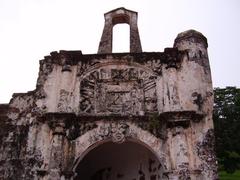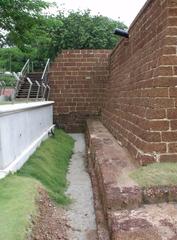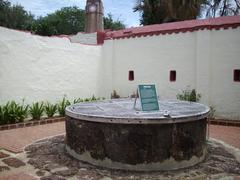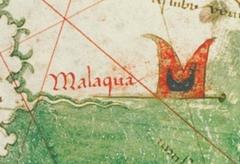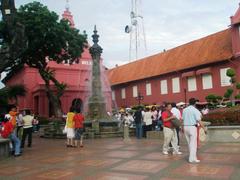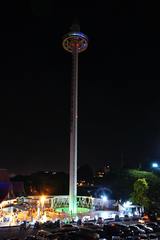Comprehensive Guide to Visiting Poh San Teng Temple, Tanjung Kling, Malaysia
Date: 24/07/2024
Introduction
Poh San Teng Temple, also known as Pih San Teng Temple, is a historic Chinese temple situated at the foot of Bukit China in Tanjung Kling, Malacca, Malaysia. Established in 1795 by Chua Su Cheong, a Chinese Kapitan, the temple serves as a significant cultural and religious site for the local Chinese community. Dedicated to Fude Zhengshen, the Righteous God of Virtue and Blessing, Poh San Teng Temple is believed to guide the souls of the deceased, ensuring their safe passage to the afterlife (Manywhere). The temple’s history is intertwined with the era of Dutch colonialism, and it features architectural marvels that reflect traditional Chinese craftsmanship, including intricate carvings and symbolic decorations (Lonely Planet). Visitors can explore the serene environment, historical artifacts, and the Sanbao Well, which is linked to the legendary Chinese admiral Zheng He and serves as evidence of the Ming Dynasty’s presence in Malacca. Poh San Teng Temple is not only a place of worship but also a hub of historical and cultural enrichment, making it an essential destination for tourists seeking to immerse themselves in Malacca’s rich heritage.
Table of Contents
- Introduction
- Historical Background
- Cultural and Religious Significance
- Architectural Features
- Historical Artifacts and Monuments
- Visitor Experience
- Practical Information for Visitors
- Nearby Attractions
- FAQ
- Conclusion
Historical Background
Poh San Teng Temple, established in 1795 by Chua Su Cheong, a Chinese Kapitan, serves as a place for the local Chinese community to worship their ancestors. The temple is dedicated to Fude Zhengshen, the Righteous God of Virtue and Blessing, who is believed to guide the souls of the deceased (Manywhere). Another theory links the temple to the legendary Chinese admiral Zheng He, whose fleet is said to have stationed at Bukit China during his voyages in the early 15th century. The temple also features the Sanbao Well, dug by Ming Dynasty troops as evidence of their presence (Manywhere).
Cultural and Religious Significance
Poh San Teng Temple is a vital site for ancestral veneration and worship for the Chinese community in Malacca. Devotees believe that Fude Zhengshen guides the souls of the deceased, ensuring their safe passage to the afterlife. The temple is located at the foot of Bukit China, the largest Chinese burial ground in Malacca with over 12,000 tombs, including many from the Ming Dynasty. The temple was built to pray for the deceased buried on the hill, making it an essential site for ancestral worship and remembrance (Manywhere).
Architectural Features
Poh San Teng Temple showcases traditional Chinese temple design with intricate carvings, ornate decorations, and symbolic elements. The main hall houses the statue of Fude Zhengshen, where devotees offer prayers and incense. The Sanbao Well, a historical artifact, connects the temple to Zheng He’s voyages. Another notable well, the Han Li Bao Well, is renowned for its ability to retain water even during droughts (Manywhere).
Historical Artifacts and Monuments
In addition to its religious significance, Poh San Teng Temple is home to several historical artifacts and monuments. The Sanbao Well serves as evidence of Zheng He’s presence in Malacca and is a popular attraction for visitors. Another significant monument near the temple is the Melaka Warrior Monument, commemorating the contributions and sacrifices of Chinese warriors who defended Malacca (Manywhere).
Visitor Experience
Poh San Teng Temple offers a unique and enriching experience for visitors. The serene environment, coupled with its historical and cultural significance, makes it a must-visit destination in Malacca. Visitors can explore the temple’s architectural features, offer prayers, and learn about the history of the Chinese community in the region. The temple is also a starting point for exploring Bukit China, the largest Chinese burial ground in Malacca. Visitors can take a leisurely walk up the hill to view the ancient tombs and enjoy panoramic views of the surrounding area.
Practical Information for Visitors
- Location: The temple is situated at the foot of Bukit China in Tanjung Kling, Malacca.
- Visiting Hours: Generally open from early morning until late afternoon. Check specific hours before planning a visit.
- Entrance Fee: No entrance fee, but donations are welcome to support maintenance.
- Dress Code: Dress modestly and respectfully as the temple is a place of worship.
- Accessibility: Accessible by car with nearby parking. Public transportation options are also available.
Nearby Attractions
Visitors can also explore nearby attractions such as the Melaka Warrior Monument and the ancient tombs on Bukit China. The combination of religious, historical, and natural attractions makes Poh San Teng Temple a comprehensive destination for tourists.
FAQ
- What are the visiting hours of Poh San Teng Temple? The temple is generally open from early morning until late afternoon.
- Is there an entrance fee for Poh San Teng Temple? No, but donations are welcome.
- What should I wear when visiting Poh San Teng Temple? Dress modestly and respectfully.
Conclusion
By visiting Poh San Teng Temple, tourists can immerse themselves in the rich history and cultural heritage of the Chinese community in Malacca. The temple’s historical significance, serene environment, and comprehensive visitor experience make it a memorable and enlightening destination for all.
References
- Manywhere. (n.d.). Poh San Teng Temple. Retrieved from Manywhere
- Lonely Planet. (n.d.). Poh San Teng Temple. Retrieved from Lonely Planet
- Wikipedia. (n.d.). Poh San Teng Temple. Retrieved from Wikipedia
